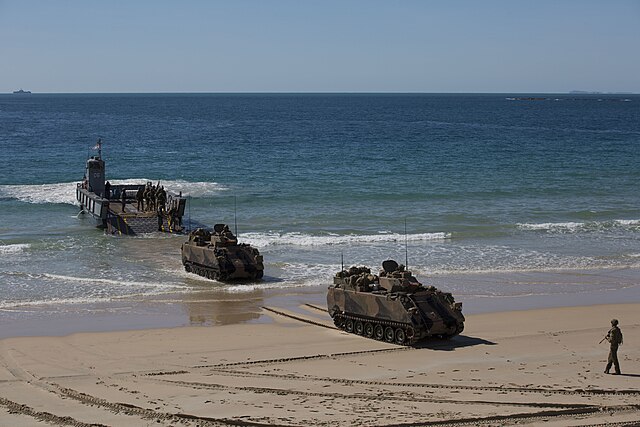The Continental Marines were the amphibious infantry of the American Colonies during the American Revolutionary War. The Corps was formed by the Continental Congress on November 10, 1775 and was disbanded in 1783. Their mission was multi-purpose, but their most important duty was to serve as onboard security forces, protecting the captain of a ship and his officers. During naval engagements, in addition to manning the cannons along with the crew of the ship, Marine sharpshooters were stationed in the fighting tops of a ship's masts specifically to shoot the opponent's officers, naval gunners, and helmsmen.
Continental Marines land at New Providence during the Battle of Nassau
Continental marines in a shipboard role.
1975 postage stamp depicting the Continental Marine uniform
Amphibious warfare is a type of offensive military operation that today uses naval ships to project ground and air power onto a hostile or potentially hostile shore at a designated landing beach. Through history the operations were conducted using ship's boats as the primary method of delivering troops to shore. Since the Gallipoli Campaign, specialised watercraft were increasingly designed for landing troops, material and vehicles, including by landing craft and for insertion of commandos, by fast patrol boats, zodiacs and from mini-submersibles. The term amphibious first emerged in the United Kingdom and the United States during the 1930s with introduction of vehicles such as Vickers-Carden-Loyd Light Amphibious Tank or the Landing Vehicle Tracked.
A Crusader tank landing on a beach from a Tank Landing Craft in a 1942 test
South Korean Type 88 K1 MBT comes ashore from an American LCAC in March 2007.
Two Australian M113s disembarking from a landing craft during a training exercise in 2019
The Bayeux Tapestry depicts the 1066 Norman invasion of England with a force of some 8,000 infantry and heavy cavalry landed on the English shore.







